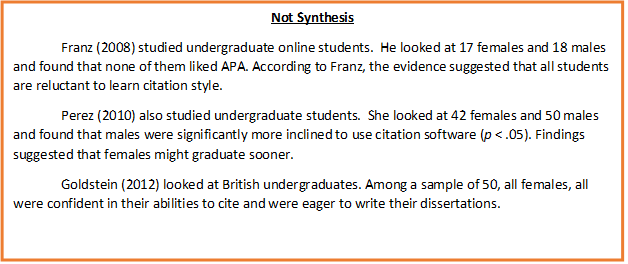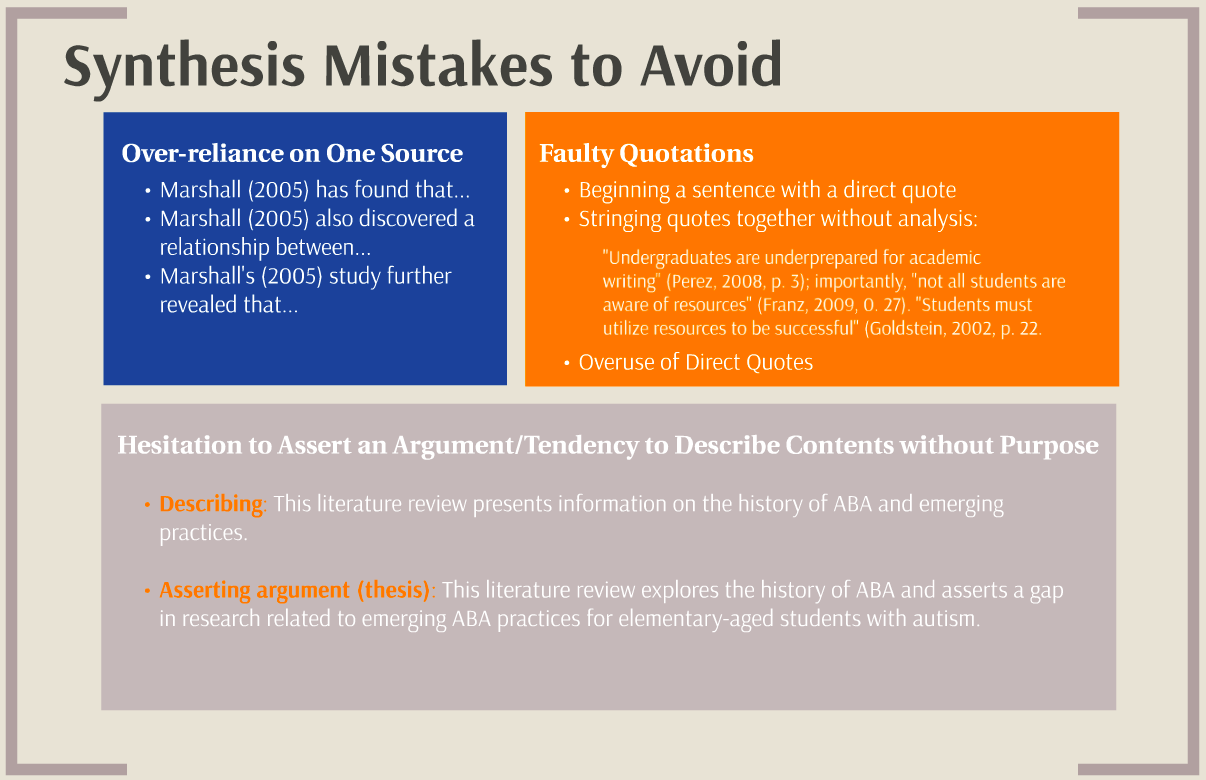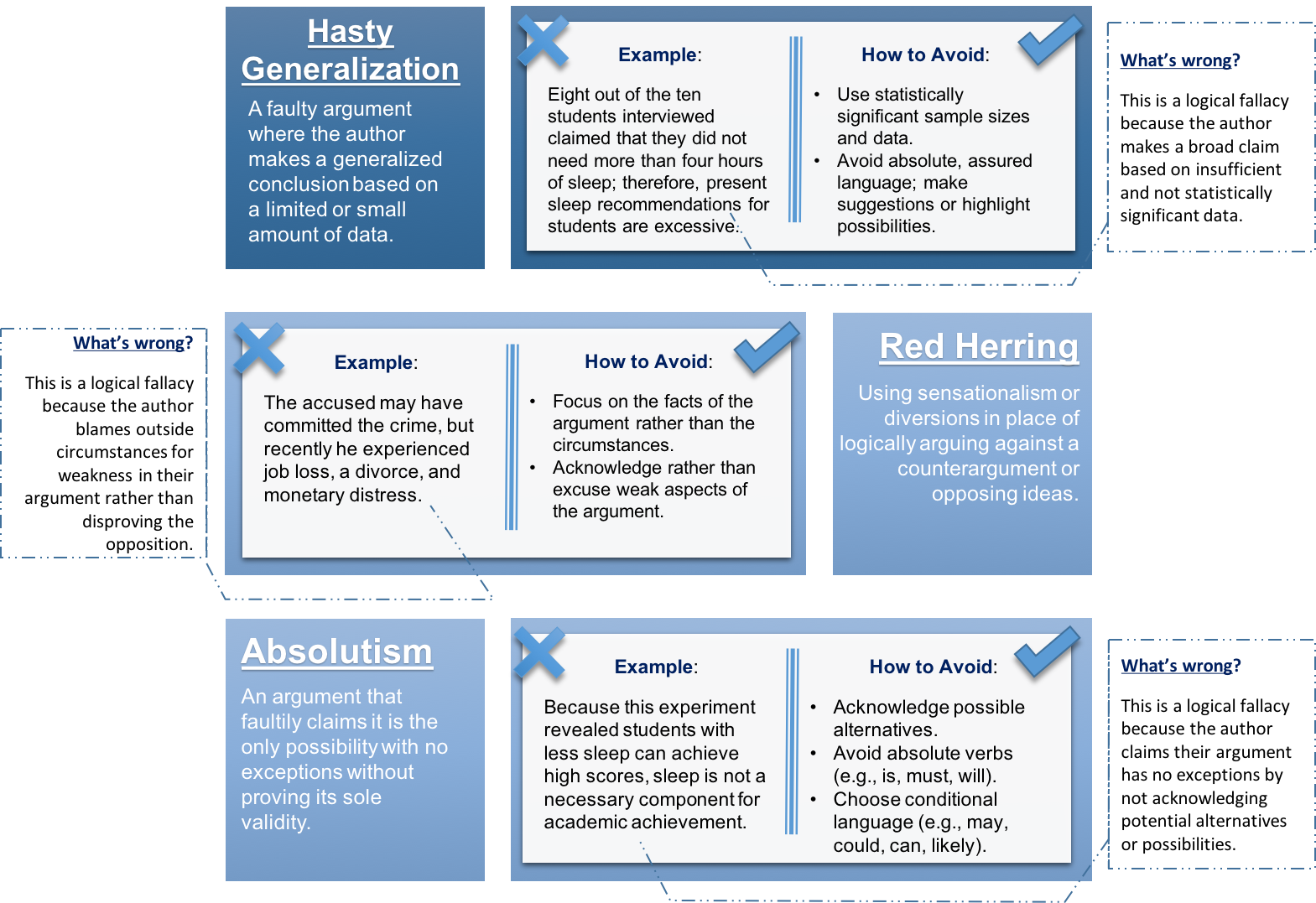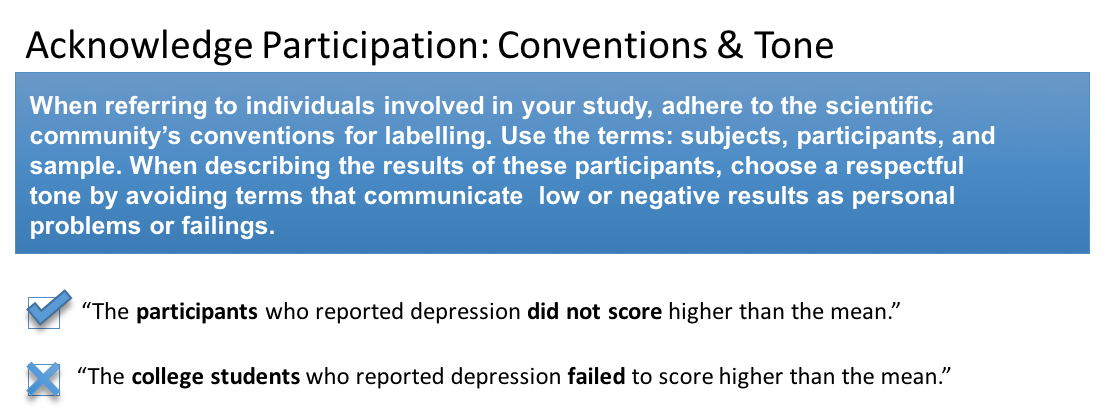Building an Argument
I need help with…
Synthesis
What is Synthesis?
Synthesis refers to reporting the literature in a way that compares, makes contrasts, and critically analyzes what is found in the existing body of literature in any given field (and often across fields).
For instance, a literature review must present an organized, objective analysis of the current literature related to your field of study and research topic. This means the literature review (aka, the synthesis of sources) needs to be free from your opinion, personal experience, embellishment, and so forth. However... that doesn't mean you don't have a critical role to play on the page. As the author of the literature review, you are:
The Detective
Identifying a research problem;
Drawing key ideas from literature about that problem;
Connecting those ideas into a logical narrative.
The Analyst
Building your case about connections between key ideas;
Persuading readers with your logical narrative.
The Narrator
Seeing relationships between sources
Fitting pieces (arguments) together to reveal the whole (state of knowledge on this topic in your field).
Avoid forcing a relationship if one is not apparent.
Be willing to drop a source if it does not play a logical role in the story.
Find relationships that are not only interesting but also relevant to your study’s focus/thesis.
Writers need to follow the four steps below to arrive at a well organized, comprehensive synthesized literature review. Steps 1 and 2 are covered in other areas on our website, and read on for details on Steps 3 and 4.
Creating an Outline & Organizing by Theme
Performing Synthesis: Organizing by Theme
Synthesis means focusing on the themes that develop across the sources that you’ve reading. It’s distinctly different from an annotated bibliography, which summarizes one article at a time. Although you might begin with a list of annotations, your final literature review must reflect synthesis:
To create your outline, first take out the notes that you took while reading, and then:
Narrow your topic to a specific topic sentence and/or thesis statement. This statement should clearly and concisely convey to your reader the paper’s purpose and serve as a basis for the argument you will make.
Create a list of main ideas or themes that you identified in your note taking process. If you were thorough in your note taking, this step will likely be very easy. If not, you might need to spend some additional time brainstorming and reviewing your sources. Be critical of the ideas you plan to include. Do they advance your argument? Do they offer a counterargument? Do they aid in understanding?
Organize the main ideas in your list into a logical order. This means following a logical progression of idea development. Or, more simply, building a clear argument. Decide what you need to say and in what order makes the most sense to say it.
Add in sub points and specific evidence to the main ideas.
Review and adjust the outline once more to make sure it responds to the assignment guidelines
Quick Tips:
Create outline using the correct APA headings
Fill in the outline with the notes you have taken
Include your APA citation in ALL notes on your outline
Feel confident in your Outline organization and content before you begin writing
Here's an example of what an outline using APA headings might look like:
How to Synthesize: Understand the Difference between Summary, Paraphrasing, & Synthesis
Summary
An overview in your own words and sentence structure of important information in a source. Often about the same length (or shorter) as the original and includes all main points and details.
Synthesis
Important summarized or paraphrased information transformed into a new interpretation, resulting in student’s (and reader’s) greater understanding of the topic. Synthesis is a combination of ideas that convey how sources (theories, studies, books) interact with one another.
Paraphrase*
An articulation in your own words and sentence structure of an important page, section, paragraph, or idea in another source. Is often the same length or longer than the original, focusing only on information that is relevant to the context in which it is being used (i.e., in relation to the other content with which it is being synthesized).
*What is paraphrasing?
Paraphrasing is a higher-order writing skill - one that is required in research writing for presenting background information, research problems, and literature reviews.
Here are some process tips for paraphrasing:
Read the original passage several times through so that you are sure you understand it.
Put the original passage out of sight (e.g., close the document on your computer, close the book, tuck the article away in a drawer)
Open a blank document
Talk to someone about the original passage; do your best to explain it verbally in your own words
Write the idea in your own words
Here are two paraphrase templates you can use to begin practicing paraphrasing and avoid plagiarism:
Synthesis Templates
Here is a template to help you practice your synthesis skills. The checklists are designed to help you ensure that you have all the necessary components of synthesis in your paper. You can use them as a revision tool or as a brainstorming tool to get started.
Avoiding Synthesis Errors
Avoiding Logical Fallacies
What is a logical fallacy?
Logical fallacies refer to errors in an author’s reasoning and therefore writing that makes the overall argument less believable or credible for the reader. Essentially, logical fallacies impair the communication of the author’s ideas, leading to a less convincing argument by weakening the presentation of the author’s logic. Following you will find a definition of logic and the most common logical fallacies that authors make.
Logic
In writing, logic refers to a pattern of explicating the relationship and connections between an author’s claim, evidence, and conclusions. Logical writing contains clearly described claims, evidence that proves these claims, and conclusions that explain the validity and significance of the overall argument. If one of these components is compromised (i.e., a logical fallacy), then the author’s argument becomes less strong and less believable.
Logical Fallacies: Explanation, Examples, and Editing Tips
Reducing Bias
Explanation and Examples
Bias in writing refers to unfounded and unreasonably negative or positive treatment of a topic. APA mandates that authors avoid “perpetuating demeaning attitudes and biased assumptions about people in their writing” (pp. 70-71). Biases can be made regarding the treatment of gender, sexual orientation, racial/ethnic group, disability, and age. To avoid these biases, APA recommends adhering to three specific guidelines for reducing bias:
Guideline One: Describe at the Appropriate Level of Specificity
To avoid biases, writers should choose language that accurately represents the topic or person(s) discussed. To avoid biases, follow these specification guidelines:
Guideline Two: Be Sensitive to Labels
To avoid biases, writers should choose language that accurately represents the topic or person(s) discussed. To avoid biases, follow these specification guidelines:
Guideline Three: Acknowledge Participation
APA has specific rules regarding certain types of pronoun usage in attributions, gendered reference.


























